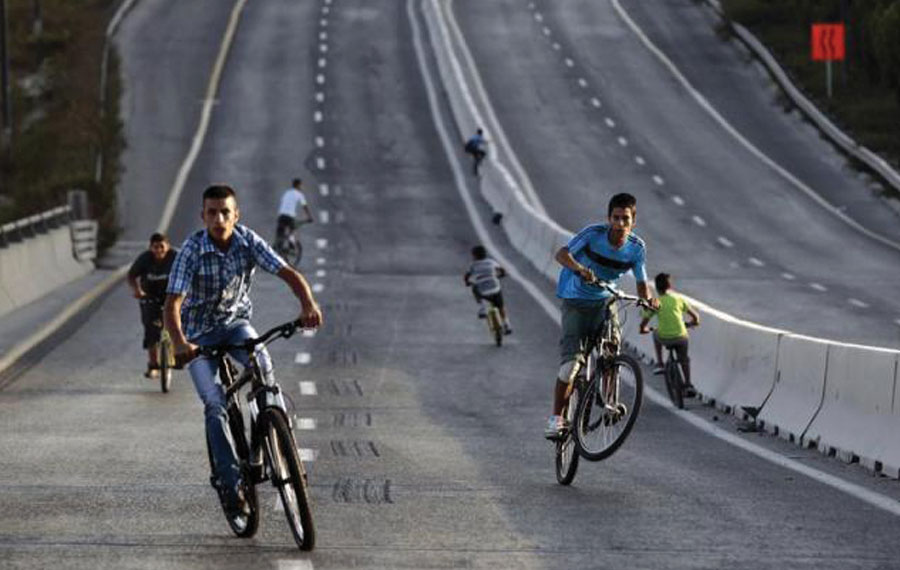 Photo by Ammar Awad/Reuters
Photo by Ammar Awad/Reuters In a study on Israel-Diaspora relations not long ago, a pop quiz was included to test the participants’ knowledge about “the other side.” American Jews were asked about Israel. Israeli Jews were similarly asked about Jewish America. Among the questions Israeli Jews were asked: What is the traditional dish eaten by American Jews on Christmas Eve? The options were: 1. Pizza; 2. Chinese; 3. Cholent; 4. Herring.
We could have asked similar questions about Yom Kippur. What do we Jews do on Yom Kippur? According to the Pew Research Center, 58 percent of American Jews attend services at a synagogue. In Israel, about 66 percent of Jews attend synagogue services, according to a study by Israeli Judaism, a project of the Jewish People Policy Institute. And what about the rest of us? What about those — in Israel a majority — who go to the synagogue for Kol Nidre but don’t spend the whole day in prayer? Let me put it in a pop-quiz format: What are secular Israelis known to do on Yom Kippur? 1. Eat; 2. Go to work; 3. Pray; 4. Ride bicycles.
If you’ve ever been to Israel on Yom Kippur (preferably not in Jerusalem), you’d know that the answer is No. 4 — this day has been transformed into a kind of national bicycle day. About half of all secular children (that is, the children of half the Jewish population) ride bicycles on Yom Kippur. Adults watch their children, and some — about a quarter of “totally secular” Israelis (almost one-third of the adult Jewish population) — also ride. If you come to Tel Aviv, where I live, the scene is remarkable. Streets and highways are empty of cars but busy with bicycles.
Exact numbers and percentages were collected by professor Camil Fuchs, Israel’s leading pollster, who works with me on the Israeli Judaism project. You can see some of the numbers on the chart on this page. But truly, exact numbers don’t matter. The trend matters. The changing culture of Yom Kippur matters. The widening gap between Israel’s and Los Angeles’ Yom Kippur matters. Indeed, there is an unavoidable cultural gap, as L.A. streets and freeways would not accommodate such a new Jewish tradition.
“I am stunned, puzzled and excited when I see the thousands on bicycles on my way to shul.”
When I show these numbers to Jewish audiences, there is an immediate tendency for everyone to begin debating whether this trend is good or bad. We all have opinions, but these also barely matter. A collective decision by a vast number of Israelis was made, and they manifest it in practice. If you think this is terrible, it’s your problem. If you think it’s wonderful, come join them. If you wonder about the meaning of it all, well, in this case, you ought to join me. You are a member of my camp.
I am stunned, puzzled and excited when I see the thousands on bicycles on my way to shul. I feel lucky to live in such times and to be able to observe and study a culture that is changing before my eyes. I suspect that this is the meaning of what we see: It is a changed Israeli-Jewish culture that must accommodate Israelis’ disinterest in strict halachic religious practice — convincing them to spend all day in shul would be impossible — while also accommodating Jewish Israelis who want to preserve Yom Kippur as a special, quiet, singular day.
Can Yom Kippur survive such a dramatic shift? Well, we don’t know if this shift will hold for very long — it is rather new. We also don’t know if this bicycling day will remain mostly a children’s activity or become a growing trend of adults riding on Yom Kippur. Of course, one must consider the fact that riding bicycles and fasting can be tricky, and about three-quarters of Jewish-Israeli adults fast during all or part of Yom Kippur.
But to provoke your interest, and maybe ignite a contemplation, try thinking about it this way: For about 1,000 years of Jewish history, Yom Kippur involved sacrificing ox and sending scapegoats to their death. For about 2,000 years, Yom Kippur was about prayer and contemplation. Maybe what we see are the early stages of a new Jewish era. Maybe what we see are the early stages of Yom Kippur’s next evolution.





















 More news and opinions than at a Shabbat dinner, right in your inbox.
More news and opinions than at a Shabbat dinner, right in your inbox.